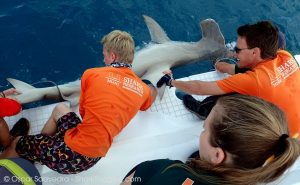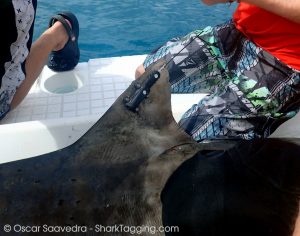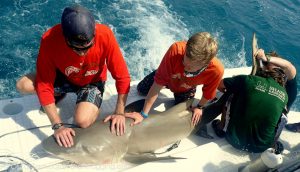Gulliver Field Studies in Marine Science Students have Amazing Day Shark Tagging with the University of Miami
By Frank Gissoni
On June 19th 2015, we were greeted at the Diver’s Paradise boat at Crandon Marina by Captain Eric and the University of Miami’s RJ Dunlap Marine Conservation team. Cap and the team went over some basic rules and procedures with us. Our special guest, fishing celebrity Peter Miller, host of the TV show Bass to Billfish and proud Gulliver parent arrived at the dock with a large fresh Amberjack that he caught for our trip while filming an episode the day before. The RJ Dunlap Team briefed the students and the rest of our group. Our team included Luis Ceballos, whose daughter was in the class, and Miller Drive Registrar Miriam Vizoso. Our tasks would include; buoy and bait deployment, measuring the animals, taking a fin clip for future DNA analysis, and tagging the animals. We were also charged with testing the reaction of the shark’s nictitating membrane (eyelid) to determine whether the animal is under any stress during the procedure! If any shark displayed any stress during the tagging and data collection process the team released the animal immediately. The safety of the team and of the sharks was paramount and all information the RJ team convey was intensely absorbed by the students. Before we knew it the engines roared and we were off.
Cruising along at idle speed through the Manatee Zone just outside of the marina, our optimism was palpable. After all, we all had reasons to be optimistic, there were clear blue skies, light wind, calm seas and we were armed with the freshest bait anyone could ask for. As we headed north past Government Cut, signs of life were everywhere. Birds hovered over schools of bait, flying fish took to the air as we passed, and even a free jumping sailfish playfully danced for us in an amazing acrobatic display. Finally we had arrived at the location. We were about 3 miles (4.8KM) offshore in about 150 feet (45M) of water, when we began setting our lines. We were using a drum line setup. First the baited hook and line went in followed by a 35 pound weight and lastly the buoy. The students stepped up one by one to deploy the lines, after all why not get the youngest and strongest involved first. We placed our lines one by one, a line of golden Sargassum Seaweed guided our path like our own yellow brick road. As the team was deploying buoy number nine the Cap called down from the flybridge. We had a shark already on the number eight buoy. The tone was set for the day. There indeed was a shark, a beautiful female sandbar shark golden brown in color and about 7 feet long. Everyone got to work. The students and the UM team worked with the speed and efficiency of a Nascar pit crew, measuring, recording data, taking samples and finally implanting a spaghetti tag. In just a few moments the shark was safely off on her way. The specialized circle hook, designed to catch in the jaw of the shark, did its job as usual and the shark with a powerful sweep of her tail splashed the team at the boat’s stern as she swam off. We barely had time to high five and celebrate when the Cap yelled down again, “buoy number six!” Off we went. This time it was a large bull shark, a powerful stubby nosed dark grey boy 7.5 feet (2.3 m) long. This was what we were looking for, a perfect candidate for a sonic tag. This time only the RJD team worked on the shark. The tag about the size of a thumb drive was implanted in the shark’s abdominal cavity, and after a few stitches he was on his way. This shark was going to be the first specimen of a new research project studying the movement of local populations of bull sharks. We told the RJD team we would be interested in adopting this shark through their adoption program and naming him Gulliver, so we could all watch Gullivers’ travels.
The learning opportunities and cross curricular ties would be enriching for Gulliver Schools. Our day continued at the same frantic pace it began with. Shark after shark was brought onto the boat, another male bull shark, and six more female sandbar sharks all about the same size were caught. Each of these sharks displayed tooth rakes on their heads and sides, the tell-tale signs of mating. These bite marks are the result of sort of a shark embrace and the female is anatomically prepared for this with her extra thick skin. What a day! Muscles were sore, skin was sunburned, gallons of water had been consumed, eight sharks tagged and safely released. The day could get no better, then it did. As we began retrieving the last of the setups, one had a heavy shark on the line. As we got the shark closer we could believe our eyes. It was a very large great hammerhead shark. The whole boat exploded into action. Hammerhead Sharks are particularly sensitive to stress so this shark had to be tagged quickly. Members of the RJD team grabbed hold of the sharks’ body after a safety lasso was secured and the Gulliver team grabbed on to the RJD Team to keep them from going overboard. One member of the RJD team got in the water with his GO Pro and recorded the event. It was controlled mayhem. This shark was to be satellite tagged. The tag was quickly affixed to the dorsal fin of the shark and measurements were taken. The Cap yelled down from the bridge, “My boat is 13 feet across the stern.” We could all see the shark was longer! “Ninety three centimeters across her head from eye to eye” someone yelled out. “Over three feet wide, and her dorsal fin is almost as tall!” We were all amazed! After a few minutes she was ready to go. Pat from the RJD Team was already in the water. He swam her off and gave her a little push, she faded from our view into the cobalt blue water and our experience with the great ocean predator was over. We had accomplished our mission. On the way back to the dock we reflected on our day. Eleventh grader Niles Miller called the day “Epic!” Miriam Vizoso claimed, “What an amazing day for the students!” Jasmin Thernhurr said, “This was a once in a lifetime experience.” Freshman Paula Ceballos gushed, “Best field trip ever Mr. Gisonni.” I could not have agreed more.



